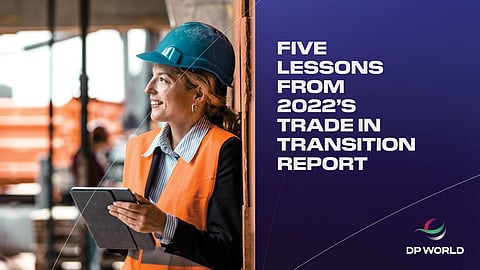Five Takeaways from 2022’s Trade in Transition Report
Trade bounced back during 2021 – according to The Trade In Transition study by the Economist Intelligence Unit, sponsored by DP World. Driven by this growing demand, exports have increased by 26% and imports are going up by 14% year on year too.
However, production levels have been unable to keep pace with this demand, leading to a surge in supply chain shortages. In response, half of the companies surveyed in the report limited their imports in 2021 – and expect no change in 2022.
So, what can we learn from this – and how can it shape the future of trade? Here are the top five takeaways from 2022’s Trade In Transition Report, Sultan Ahmed Bin Sulayem, Chairman & CEO of DP World:
1. Inflationary Pressure Is Increasing
New waves of COVID-19 led to staff staying away from work to quarantine or recover, reducing output in many industries.
But for some industries, such as agriculture or microchip production, supply is relatively inelastic, and producers cannot easily ramp up production to meet these changes in demand.
These result in supply shortages that are driving prices up. Companies have also had to diversify their supplier base, purchasing buffer inventories from suppliers that may be more expensive – with the cost passed on to the consumer.
2. Just-In-Time is Dormant
One of the clearest trends during the pandemic has been the shift away from efficiency to resilience, from ‘just-in-time’ to ‘just-in-case’. Only 14% of companies now use a ‘just-in-time’ approach to supply chain management, preferring to build inventory buffers instead.
Given the redundancies this builds into a business, companies must seek efficiencies in other ways, such as using advanced technologies to streamline operations or implementing sustainable measures to reduce resource consumption.
3. High Transport Costs are Expected to be a Top Challenge in 2022
With sporadic lockdowns at ports and increasing health and safety measures, there have been large delays at ports worldwide, creating a serious logistics challenge.
In addition, with companies keen to maintain larger inventory buffers closer to their facilities, warehousing has been in high demand.
As a result, 30% of companies expect higher transport costs to be the top limitation for export growth in 2022, as planned expansion in port and logistics infrastructure will take months to complete.
4. Companies Reconfigured Their Supply Chains Faster Than Expected
On average, it took companies 7.9 months to reconfigure supply chains in 2021 compared with 8.5 months in 2020. This is a testament to the agility of private-sector companies as they navigated pandemic-related restrictions.
Reconfiguration efforts were directed mainly towards improving the sourcing of raw materials, managing shipping lines and logistics, and ensuring good health and safety throughout the supply chain. Technology is also playing a role.
Although over 60% of companies surveyed were already using digital platforms prior to 2021, last year companies increased their adoption of 5G technologies – digital solutions that enable seamless movement through customs – as well as advanced automation.
5. Companies Are Diversifying Their Supplier Base, Rather Than Regionalising
48% of respondents chose diversification regardless of location as their primary reconfiguration strategy, whereas only 12% of respondents were primarily regionalising.
However, I have seen that a more diverse geographical spread of supplier hubs is critical to improving supply chain resilience – and this will only happen if there is a supply chain infrastructure to support it. Improved access to regional logistics hubs will facilitate this.
Such hubs connect “remote” manufacturers to larger logistics networks, opening more trade routes.
Regional logistics hubs also help trade flow to new markets by taking in large shipments and separating them into containerised cargo that can be loaded straight onto a new ship bound for smaller markets.
Streamlining distribution in this way reduces lead times and adds flexibility to the system when demand is high.
Hope For The Future
Companies are optimistic about trade growth in 2022. Exports and imports are expected to expand by 74% and 68% respectively this year, with 43% citing new technologies as the top reason to be optimistic about international trade.
Although the survey was fielded prior to the Omicron surge, experts interviewed in January 2022 have expressed that while there may be some additional restrictions, these are likely to be temporary and are unlikely to impact the outlook for trade recovery.
We have a lot to learn from reports like this if we want to create a connected ecosystem of partners. This will enable us to share knowledge and resources to pioneer better, stronger solutions.


